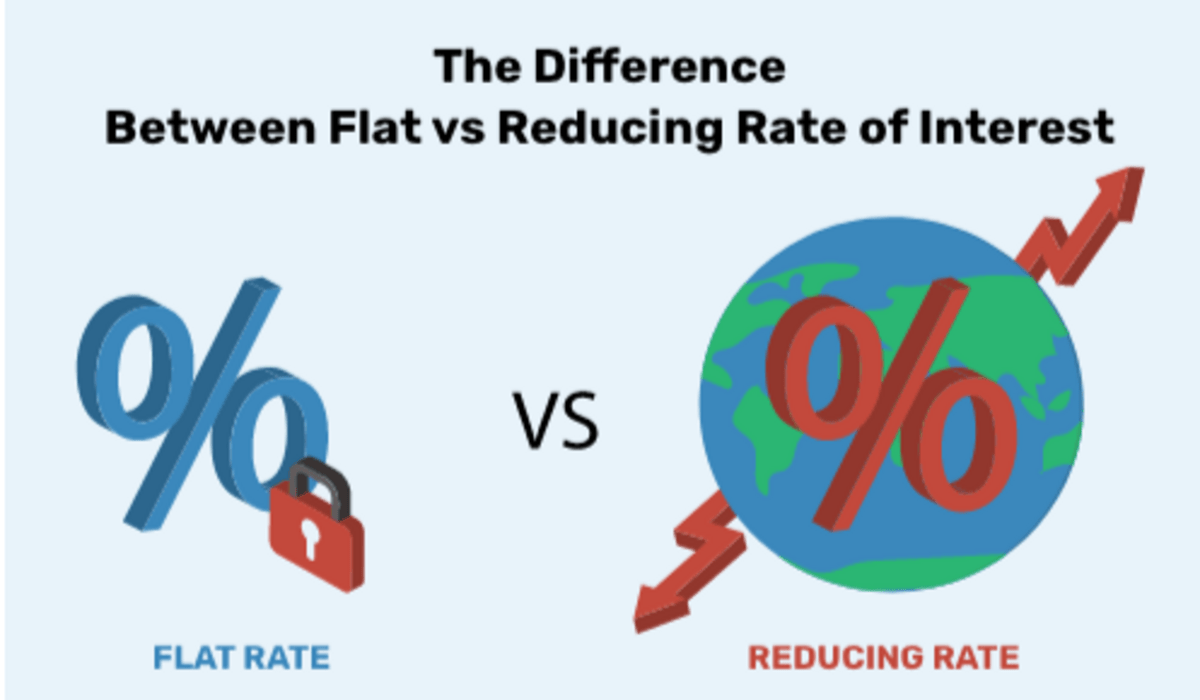When applying for a personal loan, one of the most important decisions you’ll face is choosing the right interest model. The two widely used methods for calculating personal loan interest rates are the flat rate and reducing rate models. Knowing these models and their implication will assist you in making a knowledgeable choice and even save a lot of money during the loan tenure. In this article, we’ll have an in-depth analysis of the distinction between flat rate and reducing rate interest models, weigh their advantages and disadvantages, and conclude which one is most appropriate to your financial needs.
What are Flat Rate Personal Loan Interest Rates?
Flat rate interest is the most basic method of determining loan repayments. Under this method, interest is computed on the initial loan amount (principal) over the period of the loan term regardless of the percentage of the loan already repaid.
For instance, assume you have a personal loan at an annual flat rate interest of 10% for five years. The interest is charged on the original loan amount (₹10,000) throughout the term. It does not change even as your monthly installments lower the outstanding balance over time.
Advantages of Flat Rate Interest:
Easy Calculations: Flat rate loans are simple to compute, and it is easy to know your requirements in advance.
Consistent Installments: You’ll pay the same fixed amount every month for principal and interest, which can be beneficial for budgeting.
Best for Short-Term Loans: Flat rate interest models may be better suited for loans with shorter tenures where the impact of paying interest on the full principal is less noticeable.
Disadvantages of Flat Rate Interest:
Higher Total Cost: Because the interest is being paid on the whole loan amount, flat rate loans tend to be costlier overall in the duration when compared to reducing rate loans.
Less Transparent: Customers are penalized to pay interest on money that has already been repaid several times over the course of the term.
What are Reducing Rate Personal Loan Interest Rates?
The declining/diminishing interest rate model, or reducing rate model, is more sensitive. Here, interest is charged on the outstanding loan amount (principal) for each installment. As the principal is being lessened with every payment, the interest component reduces over time as well.
For instance, suppose you are given the same ₹10,000 personal loan with a decreasing interest rate of 10% annually. Its interest is charged on the outstanding balance after each instalment payment, as opposed to the initial amount of the loan.
Decrease in Interest Benefits:
Affordable: Interest reduces with time since it’s being charged against the reduced balance, so the loan is less expensive overall.
Reasonable Payment Plan: Borrowers do not pay any unnecessary interest on previously paid amounts.
Suited for Long-Term Loans: For long loans, the benefit of lowering interest rates accumulates.
Shortcomings of Lowering Rate Interest:
A Small Amount of Advanced Calculation: The mathematics of lowering rate interest can be harder to grasp for new borrowers.
Increased Initial Payments: The first payments in lowering rate loans have greater interest components, which may be difficult for some customers.
Flat Rate vs Reducing Rate: Major Differences
So as to determine the differences between these models of personal loan interest rates, let’s discuss them:
| Feature | Flat Rate Interest | Reducing Rate Interest |
| Calculation Method | Interest is calculated in terms of percentage of initial loan amount. | Interest is calculated in terms of percentage of outstanding loan balance. |
| Overall Cost | Higher overall cost. | Lower overall cost. |
| Installment Amount | Fixed monthly installment. | Reducing monthly installment (declining). |
| Transparency | Less transparent. | More transparent. |
| Suitable for | Short-term loans. | Long-term loans. |
How to Select the Appropriate Interest Model for Your Personal Loan
Reducing rate or flat rate selection is based on your affordability, period of the loan, and repayment type. The below tips are intended to guide you:
Short-Term and Long-Term Loans: If you’re opting for a shorter term loan, the flat rate system is preferable with the ease of computation. For the longer period loans, the reducing rate system is more economical.
Budgeting Preferences: Provided that stability is your key concern for your monthly budget, flat rate loans’ fixed payments can provide comfort. However, if cost savings in total matter more to you, the reducing rate model is superior.
Loan Amount: For large loans, the reducing rate model is likely to provide much savings, especially when the term of the loan is lengthy.
Creditor Offers: Some lenders only have one interest model, so compare several lenders and their personal loan interest levels before opting for one.
Conclusion: Which Interest Model Is Better?
Finally, the choice between flat rate and reducing rate for personal loan interest rates depends on your requirement and term. Flat rate loans are certain with some monthly payments, but they are more costly in the long run with the fixed calculation of interest on the total principal. Reducing rate loans are lower-cost because the interest drops as the amount goes down—but they may begin with larger payments.
For most consumers, particularly those who take for the long term, the decreasing rate of interest model is the most cost-effective to employ in the long run. But bear in mind your lender’s terms, compare, and select a model that suits your financial goals.
Whatever interest model you decide to work with, knowing the composition of the personal loan interest rate and how it will affect your repayment plan is the secret to making intelligent borrowing choices. The clearer you understand, the surer you’ll be about handling your financial obligations!

